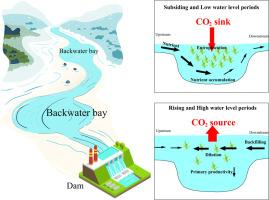三峡库区两个回水湾的养分积累和富营养化限制了CO2的排放
IF 6.3
2区 环境科学与生态学
Q1 ENVIRONMENTAL SCIENCES
引用次数: 0
摘要
水库是二氧化碳排放的重要来源。回水湾是在峡谷-水库明渠中由于蓄水作用而形成的独特水文单元。它的特点是有效的营养保留和倾向于频繁的富营养化。然而,这些回水湾的CO2排放时空动态尚不清楚。以三峡库区汉峰湖和高阳湖两个不同回水湾的CO2通量(fCO2)为研究对象,揭示CO2排放的时空动态及其驱动因素。这两个回水湾是次要的二氧化碳排放源,与三峡水库内的其他水域相比,它们的fCO2排放量较低。在三峡水库沉降期和低水位期,两个回水湾的fCO2含量明显降低,部分地区甚至因富营养化而转化为CO2汇。然而,三峡水库水位升高引起的水流倒流,稀释了藻类密度,抑制了初级生产,同时增加了CO2的排放。研究表明,营养物质富集、富营养化和水位波动共同主导了三峡库区回水湾CO2排放的时间动态。两个回水湾的CO2通量由上游向下游递减。营养物的空间分布和相关的藻类密度是驱动这种模式的关键因素。影响回水湾CO2排放的关键因素随水位变化而变化。我们的发现有助于更好地了解具有不同水文栖息地的大型水库的二氧化碳排放。本文章由计算机程序翻译,如有差异,请以英文原文为准。

Nutrient accumulation and eutrophication restricted CO2 emissions in the two backwater bays in the Three Gorges Reservoir (TGR), China
Reservoir is an important source of CO2 emissions. The backwater bay is a distinct hydrological unit formed in the open channel of canyon-reservoir as a result of impoundment. It is characterized by efficient nutrients retention and a propensity for frequent eutrophication. However, the spatio-temporal dynamics of CO2 emissions in these backwater bays remain unclear. This study investigated CO2 fluxes (fCO2) in two different backwater bays (Hanfeng Lake and Gaoyang Lake) within the Three Gorges Reservoir (TGR), to reveal the spatio-temporal dynamics and driving factors of CO2 emissions. The two backwater bays serve as minor sources of CO2 emissions, exhibiting lower fCO2 compared to other water areas within the TGR. In the subsiding and low water level periods of the TGR, the fCO2 in the two backwater bays were significantly lower, with some areas even converting into CO2 sinks due to extensive eutrophication. However, the water flow backward caused by the TGR water level elevation simultaneously enhances CO2 emissions by diluting algae density and constraining primary production. We highlighted that nutrients enrichment, eutrophication, and water level fluctuations co-dominate the temporal dynamics of CO2 emissions from backwater bays in the TGR. The CO2 fluxes decreased from upstream to downstream in the two backwater bays. The spatial distribution of nutrients and related algal density are critical factors driving this pattern. The key factors influencing CO2 emissions in the backwater bays diversified with water level fluctuations. Our findings contribute to a better understanding of CO2 emissions in large reservoirs with varying hydrological habitats.
求助全文
通过发布文献求助,成功后即可免费获取论文全文。
去求助
来源期刊

Journal of Environmental Sciences-china
环境科学-环境科学
CiteScore
13.70
自引率
0.00%
发文量
6354
审稿时长
2.6 months
期刊介绍:
The Journal of Environmental Sciences is an international journal started in 1989. The journal is devoted to publish original, peer-reviewed research papers on main aspects of environmental sciences, such as environmental chemistry, environmental biology, ecology, geosciences and environmental physics. Appropriate subjects include basic and applied research on atmospheric, terrestrial and aquatic environments, pollution control and abatement technology, conservation of natural resources, environmental health and toxicology. Announcements of international environmental science meetings and other recent information are also included.
 求助内容:
求助内容: 应助结果提醒方式:
应助结果提醒方式:


